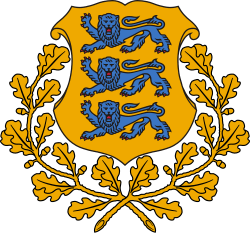Women in Estonia
|
The 1954 bust of Ellen Niit, a female Estonian literary writer born in 1928. The bust was sculpted by Erna Viitol (1920–2001). | |
| Gender Inequality Index[1] | |
|---|---|
| Value | 0.154 (2013) |
| Rank | 29th out of 152 |
| Maternal mortality (per 100,000) | 2 (2010) |
| Women in parliament | 20.8% (2013) |
| Females over 25 with secondary education | 100% (2012) |
| Women in labour force | 68.4% (employment rate OECD definition, 2015)[2] |
| Global Gender Gap Index[3] | |
| Value | 0.6997 (2013) |
| Rank | 59th out of 144 |
Women in Estonia are women who were born in, who live in, or are from Estonia in Europe.
Politics
Estonian women first gained the right to vote from Russia's Provisional Government in 12th of April 1917 together with Estonia being granted a national autonomy as a unified entity.[4]
Fertility
Between 1970 and 1990, the total fertility rate (TFR - the average number of children a woman bears[5]) of Estonian women was little over 2 children born per woman.[6] A fast decrease of the TFR occurred after independence. In 1998 the lowest rate was recorded: 1.28 children born per women. In 2001, the United Nations reported through its annual world-population report that "Estonia was one of the fastest-shrinking nations on earth, at risk of losing nearly half its 1.4 million people by mid-century". To prevent this drop in TFR, one of the steps the Estonian government took since 2004 was to start "paying" women by providing them with subsidies "to have babies" known as "mother's salary"). After giving birth and during maternity leave, working Estonian women received full monthly income for up to 15 months (equivalent to US$1,560.00); non-working women who gave birth received a monthly subsidy equivalent to US$200.00.[5] The TFR slightly recovered in the subsequent years, but fluctuated by year, and continued to remain below the replacement rate (being 1.54 children/woman in 2014).[7] As in many other European countries, the link between marriage and fertility has been weakened during the past decades: most children today are born outside of marriage (59% of children were born to unmarried women in 2014).[8] The average age of mothers at first birth in 2014 was 26.6 years.[9]
Religion
In the past, according to Estonian mythology, the ancient women of Estonia believed in the female deity and protector of pregnant women in labor known as Rõugutaja.
First woman cleric Laine Villenthal was ordinated in 1967 by Estonian Evangelical Lutheran Church.[10]
References
- ↑ "Table 4: Gender Inequality Index". United Nations Development Programme. Retrieved 7 November 2014.
- ↑ http://stats.oecd.org/Index.aspx?DatasetCode=LFS_SEXAGE_I_R#
- ↑ "The Global Gender Gap Report 2013" (PDF). World Economic Forum. pp. 12–13.
- ↑ http://feministeerium.ee/kuidas-eesti-naised-valimisoiguse-said/
- 1 2 Walker, Marcus. "In Estonia, Paying Women To Have Babies Is Paying Off". As Low Birthrates Threaten Growth, Developed Nations Watch Incentive Effort. The Wall Street Journal (New York). Retrieved 10 November 2013.
- ↑ "Main demographic indicators". Statistics Estonia. Retrieved 3 January 2013.
- ↑ http://ec.europa.eu/eurostat/tgm/table.do?tab=table&init=1&language=en&pcode=tsdde220&plugin=0
- ↑ http://www.csb.gov.lv/en/notikumi/among-baltic-states-greatest-birth-rate-growth-2014-was-registered-latvia-43062.html
- ↑ http://www.csb.gov.lv/en/notikumi/among-baltic-states-greatest-birth-rate-growth-2014-was-registered-latvia-43062.html
- ↑ http://www.eestikirik.ee/naiste-ordineerimisest-eesti-evangeelses-luterlikus-kirikus/
External links
| Wikimedia Commons has media related to People of Estonia. |
| Wikimedia Commons has media related to Women at work in Estonia. |

